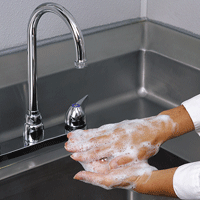Examining the tools, equipment and resources needed to maintain a sanitary kitchen.
Rudolf Fischbacher serves double duty as a professor and coordinator of Culinary Programs at Humber College. And, while teaching culinary arts is the glamorous part of the job, he’s equally committed to training students on sanitation and the tools necessary for food safety in the kitchen. “The level of compliance is very high for students,” he says. “Certification is just getting bigger and bigger in our industry.”
Like many establishments, he sticks to HACCP (Hazard Analysis and Critical Control Points) guidelines for compliance on the sanitation and safety front. While HACCP is not always mandatory, it is the barometer sanitation-conscious operators use to ensure a squeaky-clean inspection.
When it comes to getting A-plus sanitation inspection results, the trick is ferreting out anything that harbours bacteria — be it surfaces, equipment or kitchen staff.
Wall surfaces (drywall) should be made of materials that won’t crack, break or damage from moisture and/or rodents. And, in an ideal world, floor surfaces should be seamless and tiles shouldn’t be chipped or cracked.
The same goes for equipment. “It’s important to have units that support food safety and sanitation,” says Fischbacher, distinguishing between how food is handled and/or stored and how work areas are kept clean and disinfected. “Stainless-steel surfaces, for example, are easy to maintain. We like induction units because they don’t have crevices to keep clean.”
In the U.S., there is a National Sanitation Foundation (NSF) certification for equipment, explains Jim Kostuch, vice-president of TrainCan, Inc., in Toronto. “For a piece of equipment to be certified it has to have rounded edges, smooth surfaces, no grooves and no edges for bacteria to hide in during cooking.”
An equally important challenge is ensuring staff follow food-handling, handwashing and hygiene guidelines.
Smart Thinking
Sandra MacInnis, senior consultant, Operations and Planning for Designed Food Systems in Ottawa, believes in smart technology. “It’s good for operators to use it. Rational combi-ovens and Traulson blast chillers, for example, have the built-in ability to record data.”
Fischbacher agrees. “Equipment has gotten a lot smarter in that way,” he says. “Many also have a cleaning cycle in which detergents can be pumped into them, so the machine comes out spotless. Combi-ovens have led the way in that area with built-in computers and plug-in USB ports for inspectors to download the information they need when they visit.”
Dishwashers are another area where intelligent monitoring can be helpful. Ecolab has computer systems available that literally plug into the technician’s tablet, so users can see that their dishwasher temperatures are high enough to meet regulated levels as well as check the machine’s energy efficiency and chemical usage, explains Jason Cheskes, president of Above the Line Solutions, a foodservice consultancy in Richmond Hill, Ont.
Testing the waters
With temperature control a critical concern in foodservice, accurate gauges are essential. Every refrigeration and freezing unit, for example, should have a separate external thermometer checked at the beginning and end of every shift, says Kevin Freeborn, a certified management consultant with the Thornbury, Ont.-based Freeborn & Associates. “Data loggers are a great tool for tracking temperatures, especially when distributing or getting supplies delivered. You can download the time and temperature data history so you can see if food has ever entered the temperature danger zones for too long,” he adds.
Freeborn also recommends disposable T-Sticks — cardboard thermometers that can be used to check temperatures in hot holding tables, and bain marine units. On the cooling front, sanitized ice wands combined with an ice bath are an affordable alternative to a blast chiller.
But, Traincan’s Kostuch notes cost is no longer an issue, since temperature monitors are affordable. “New wireless monitors from Thermor, for example, log temperatures every 20 minutes, download the information to a computer and can cost less then $200. From a health-inspection standpoint, that’s a very valuable tool.”
Colour of hygiene
In any sanitation conversation, cross-contamination is a major sticking point. The job has been simplified with the advent of colour coding for just about everything that comes in contact with kitchen surfaces and food, including cutting boards, knives, cloths, cleaning utensils and hairnets. For example red cutting boards could be for red meats, green ones for veggies. “That avoids any risk from the get-go,” Humber’s Fischbacher says. “Kitchens can also have colour-coded posters on the walls to make it easier for employees to identify what they should be using for what food or area.”
“Using cloths in the kitchen is the most common problem in terms of cross-contamination” says Designed Food Systems’ MacInnis. “That’s why we recommend colour coding, especially when working in designated areas for allergen production.”
Two-step sanitization
Operators might also think a thorough washing of a work surface is sufficient, but it’s not. “It sounds simple, but the worst form of contamination is on kitchen counters,” MacInnis notes. “A lot of times operators aren’t aware of the risk,” from a food-allergy and cross-contamination perspective.
Sanitizers must be used after a washdown on any surfaces that have come in contact with food, Above the Line Solutions’ Cheskes says. “The biggest thing that is always a matter of contention with operators is that although they do clean their surfaces thoroughly, they are actually not sanitizing. According to code, it has to be a two-step process that requires two different products. A lot of operators don’t know this. But it is in fact the most critical step.” He adds that people believe using bleach is an effective sanitizer. “Really it’s not. It’s corrosive, it dissipates quickly and doesn’t last when exposed to air. The most effective and safest to use is a Quat sanitizer.” Quats, or quaternary ammonium compounds, are odourless, non-staining, non-corrosive sanitizers.
Hands-free
When it comes to hygiene, perhaps one of the biggest challenges is making sure proper hand-washing procedures are followed. The first step is to provide several sinks in accessible locations; the second step is to enforce proper sanitation.
To address this problem, managers should monitor sanitizer levels throughout a shift or, alternately, more sophisticated technologies could be implemented. “There are hand-soap dispensers that will count how many times they are being used,” Cheskes says. “Touch-free is also the huge thing right now for hand sanitizers and soap dispensers.”
Technology is improving. “I’ve seen automated hand-wash stations where employees must key their number into the unit before it will dispense the soap; and then will hold off dispensing water for 20 seconds. Some even have an alarm if the employee walks away before finishing the process,” adds Freeborn.
While the sanitation inspection laundry list can be long, it’s in an operator’s best interest to understand the requirements. Whether looking at building materials, kitchen design, appliances, storage practices or human behaviour, no one can afford to get a failing grade when an inspector comes to call.
Features:
Tall Order: Profiling Chef Marc St. Jacques
Open for Business: Latest Foodservice Must-Haves
Forward Thinking for Foodservice Operators
The Sizzle of Success: Burgers and Fries





















